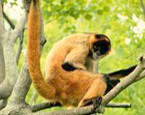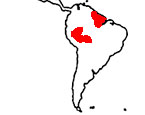|
Geoffroy's
Spider Monkey
(Ateles geoffroyi) #63-18 |
||||
|
|
Physical
characteristics and distribution |
|
Head
and body length is 382-635 mm and tail length from 508-890 mm.
Weights average 6kg. and as much as 8 kg. for captive animals.
The fur is coarse and stringy varying in color from yellowish
gray, darker gray, reddish to dark brown to almost black above,
sides are golden yellow to rufous and the underparts are lighter,
usually whitish or yellowish. Most forms have a black face with
white eyerings while others have a flesh-colored face. |
|
Description
of the brain
|
|
Animal
source and preparation
|
|
All
specimens collected followed the same preparation
and histological procedure.
|
Other Related Resources (websites and publications)
List of Specimens | Explore Collections | Brain Sections | Brain Evolution | Brain Development | Brain Circuitry | Brain Functions | Location and Use | Related Web Sites | Contact Us | Search MSU Database | Personnel | Home



